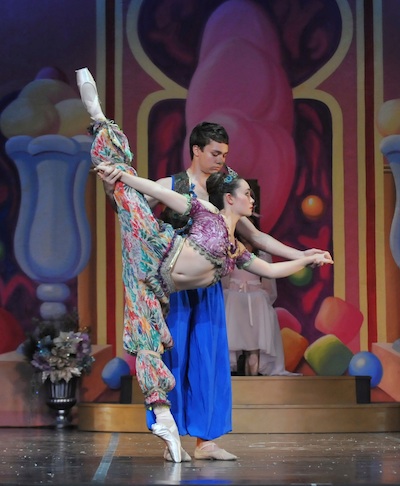
Watching a ballet performance, one may notice the fluid movements, the graceful leaps and the beauty. Through the intricate costumes and seemingly effortless movements of the dancers, the pressure upon the dedicated dancers who create the art before them is not apparent. Difficulties arise from the mental and physical demands of balancing high school with extracurriculars, as well as the lack of respect for dance as a sport. However, some dancers reach a turning point in high school where their love of dance outweighs the challenges and justifies their devotion to it.
At young ages, Jennifer Wang (‘14) and Maya Kitayama (‘14) began their ballet careers, giving them a solid foundation for other advanced forms of dance.
“Ballet is the mother of dance,” Kitayama said. “It’s the basis for all other techniques, you have to be strong in ballet to be strong in other styles.
Athletic competitions are commonly aimed towards winning a league or division; however, dance conventions often hold scholarship auditions after the competitions finish to give young dancers a sense of professional auditions.
“[They hold auditions] mostly to mimic and help dance students practice for the real world when they want to go out and audition for real jobs,” Kitayama said.
Even though Wang has not competed in many events recently, she considers competitions to be exciting and inspiring, but also slightly preferential.
“I haven’t been doing a lot of competitions lately,” Wang said. “Recently, I have just been doing one at my studio, it is called ‘Youth America Grand Prix’. It is kind of different because it is hard to judge an art because part of it is preference, but I think it is good for motivation and it can be a lot of fun.”
Unlike other sports, ballet includes an aspect of artistic performance which can be both stressful and rewarding for a dancer.
“It is an art, in the sense that you are performing to share your enjoyment of what you are doing,” Wang said. “That is not necessarily what you do in a sport.”
Although it is different from other sports, Kitayama still considers dance to be a sport equal to other strenuous athletic activities, as it requires hours of training and is physically demanding.
“Dance is the full package,” Kitayama said. “It is really athletic… The hardest part is that you have to move in such a way and also make it seem as if it doesn’t hurt at all… It is supposed to look effortless and that in itself is a challenge… I do as much exercise as most other Paly athletes, if not more. If people consider [gymnastics and figure skating] a sport, I still don’t understand why they won’t consider dance a sport.”
Along with giving dancers a form of exercise which challenges their physical abilities, dance can also develop their leadership qualities.
“Maya has trained in all forms of dance, that has really changed her approach to ballet,” Cindy Ginanni, director of the studio Dance Connection, said. “Maya has skills that students who come only from ballet training do not have. She’s a really versatile dancer, she does her own choreography and she’s a true leader.”
Although ballet is a key component to dancers’ growth, other forms of dance also teach students about the ever-changing world of dance.
“I really enjoy doing modern, contemporary stuff,” Kitayama said. “Working on those kinds of pieces is what I enjoy the most because they kind of evolve over and over. Since it is not ballet, it is a little more up to interpretation. I think you learn a lot from that process.”
Along with learning other styles of dance, travelling can also be beneficial to improving ballet techniques. Similar to many other devoted athletes at Paly, Kitayama and Wang have traveled out of state to take classes and compete. Wang traveled with her studio to Russia last February to learn about ballet.
“We went to the Bolshoi Valley in Moscow,” Wang said. “We traveled there and we took classes with their teachers and we also got to watch their students dance in class.”
Kitayama has also traveled to attend a dance program. She attended a modern dance company, Alvin Ailey, in New York for six weeks during this past summer. These experiences, along with practice and competitions, can heavily impact not only the dancers, but also their families. In Kitayama’s case, her parents did not always view dance as a promising activity.
“I think for a long time my family thought dancing was a hobby,” Kitayama said. “My mom would definitely get annoyed because it cost a lot of money and time…As I have been getting older they have [realized] that I am really passionate about it and they have become more supportive.”
For most ballet dancers and their families, the winter season is associated with many things, one being the Nutcracker. For Maya Kitayama (‘14) the Nutcracker is not only a performance, but also something to look forward to. As she grew older and progressed as a dancer, her role became more challenging. This year, she worked her way up to the Sugar Plum.
“I have been waiting for a long time [to be the Sugar Plum] and now I get I finally get to do it,” Kitayama said.
Wang was also given the chance to perform the role of Sugar Plum in the Nutcracker, due to another dancer’s injury. Although the chance to perform a more prominent role in a show can be exciting, dancers may feel strained to learn large parts of a show in short time periods.
“When I was 14, the person who was supposed to play the Sugar Plum got injured about three weeks before the show,” Wang said. “I was asked to start learning it in case she couldn’t do it…I started learning it and about two weeks before [the show], they said [I] was going to do it. It was probably the most stressful situation ever, but I got through it and it turned out to be one of my proudest moments of dancing.”
Injuries, especially to the foot or ankle, are not uncommon, and can force dancers to stop ballet for long periods of time. Wang recounted an injury that sidelined her for seven months.
“I had an Os Trigonum in my ankle, which is an extra bone,” Wang said. “I ended up getting it removed, so I was out for around seven months…It was weird for me just going home after school and not going to ballet. I did some other stuff… but it was not the same as actually dancing.”
Kitayama can relate to the feeling of not being able to do what she loves because of an injury. She also had to take a break from dancing in sixth grade, when she broke her foot jumping on a trampoline.
“It was really rough because that was the first major injury for me and I was out for three months,” Kitayama said. “I realized that [dance] was what I wanted to to. Not being able to do it made me realize that it was something I wanted to pursue in the future.”
Along with the physical strength of coming back from an injury, dancers may also experience a growth in their mental toughness due to the tensions attributed to the dance community.
“[Ballet] is really amazing because it’s good for your body,” Kitayama said. “It’s also very mental and emotional and you have to be very strong as a person in order to pursue it, because the ballet world is very judgemental…”
Pressure, a large part of ballet, can be influential upon a dancing career. Performances, body image, and the overall expectation of success can take a toll on a dancer.
“[Ballet] is great and there are amazing people who are a part of it, but a lot of times there is pressure to look a certain way, or dance a certain way or reach this level of advancement,” Kitayama said. “It’s definitely difficult in that sense.”
Although the pressure of ballet is potentially harmful for some dancers, Kitayama considers it an obstacle worth overcoming.
“I think that pressure is really cool for a person because if you can manage [it] then you come out as a stronger person,” Kitayama said. “As a con I would say that it is a lot of pressure that could be detrimental to a person, and it’s obviously time consuming, but if you love something then it’s worth it. [Dance] is a lot of time, but it’s amazing.”
Time commitment is another stressful component of dance, which can impact dancers’ social and academic lives. Balancing dance with school can pose multiple challenges for dancers. The large work loads of high school and a demanding dance schedule can be overwhelming. Wang finds it difficult to divide her time between dance and school, as she takes ballet at a studio in San Francisco.
“I have a sixth and seventh prep so I can get to ballet on time,” Wang said. “I usually get home at eight every day during the weekdays, so I do not have a lot of time to do my homework. It is usually okay if I manage my time.”
Although ballet complicates dancers’ abilities to complete their schoolwork, dance can also be an outlet from the stressful academic world.
“It is such a nice escape for me,” Kitayama said. “Obviously school is rough and life is hard. Being able to go to ballet class and forget everything, leave it outside, and just focus on something that incorporates my body, music, and movement is really powerful and a really good stress release.”
Ballet can also be a rewarding activity which allows dancers to showcase their talents.
“[I dance] mostly for the performances,” Wang said. “You get to show what you have been rehearsing for finally on stage, and you get to show other people. It is a lot of fun.”
Kitayama also enjoys ballet performances, especially the effect which her dancing can have upon audience members.
“I think every once in a while you have a performance where someone is actually touched by it.” Kitayama said. “It doesn’t happen often, but when it does it is the most incredible feeling. [When] you are sharing your passion with someone and they in turn feel something, that is the coolest thing ever.”
Kitayama experienced one of these touching moments first hand last year during an emotional partner piece at a competition.
“I was competing in this piece last year with my friend Josh [Wilson],” Kitayama said. “It was very emotional and mature. We were skeptical as to whether we could pull it off. We competed at this one venue and we were kind of nervous… I looked up as we were bowing and leaving the stage and I could see one of the judges crying. I couldn’t even process it in the moment…I couldn’t believe I had made him cry. I had affected him in such a way that he actually felt something. That was such a proud moment for me.”
Kitayama appreciates the wonder of dance itself and how it affects her life.
“I love the beauty of it,” Kitayama said. “Dance is such an amazing feeling when you can go into a room, take a class, look in the mirror every once in a while [and think] I feel beautiful, that is so cool.”
Not everyone can relate to the motivations of a ballet dancer; however, most individuals have experienced the feelings that cherished activities can bring. The pressure, the challenges, and the joy of achievement unite all different types of talents, passions and interests, whether it’s horseback riding, football, chess or dance.




